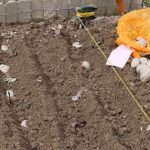Square foot gardening presents a revolutionary approach to growing vegetables that has gained popularity in recent years. Rooted in the principle of maximizing efficiency and utilizing limited space, this gardening method offers numerous benefits for both experienced gardeners and beginners alike. In this article, we will delve into the concept of square foot gardening, explore how it can optimize vegetable yields while saving space, and provide a brief history of its origins.
Square foot gardening is a method that involves dividing a garden bed or container into small square sections and planting different crops in each section. This technique assists in making efficient use of available space, especially crucial for urban gardeners or those working with limited areas.
By focusing on designated squares rather than traditional rows, square foot gardening allows plants to grow closer together while still providing adequate room for each vegetable’s needs. This close spacing minimizes wasted space and maximizes overall vegetable production.
With its origins dating back to the 1980s, square foot gardening has grown in popularity due to its effectiveness and versatility. Not only does it enable gardeners to make the most out of their available space, but it also promotes healthy plant growth. When plants are adequately spaced, they have ample access to sunlight, water, and nutrients essential for proper development. The optimized spacing facilitates air circulation around plants, reducing the risk of diseases caused by damp conditions or overcrowding.
In the following sections of this article, we will dive deeper into the science behind vegetable spacing and offer practical tips for determining appropriate spacing requirements for your square foot garden. Additionally, we will explore ideal vegetables for this method along with companion planting techniques that enhance productivity.
By providing insight into maintaining healthy plants in confined spaces and sharing success stories from experienced gardeners, readers will gain valuable knowledge and inspiration to embark on their own square foot gardening journey.
The Science Behind Vegetable Spacing
Proper vegetable spacing is essential for healthy plant growth and optimal yields in square foot gardening. In this section, we will explore the scientific principles behind vegetable spacing and why it is crucial to consider when planning your garden.
One of the main reasons why vegetable spacing is important is to ensure that each plant has enough access to sunlight, water, and nutrients. When plants are spaced too closely together, they end up competing for these resources, resulting in stunted growth and smaller harvests. On the other hand, when plants are spaced too far apart, valuable garden space goes unused and there is an increased risk of weeds taking over.
Factors to consider when determining spacing requirements include the size of each mature plant, its root system, and its overall growth habit. For example, leafy greens like lettuce or spinach can be grown in closer proximity because they have smaller root systems and grow relatively compactly. On the other hand, vining crops like tomatoes or cucumbers require more space due to their sprawling growth habit.
Improper vegetable spacing can have several negative consequences. In addition to reduced yields, overcrowded plants are more susceptible to diseases and pests as air circulation becomes limited. Moreover, crowded plants trap moisture between them, creating a humid environment that promotes fungal infections.
To ensure proper spacing in square foot gardening, it is important to calculate the precise requirements for each crop you plan to grow. This involves understanding the recommended plant-spacing guidelines provided by reputable sources and taking into account any specific instructions or recommendations for individual vegetables.
| Vegetable | Spacing (inches) |
|---|---|
| Lettuce | 4-6 |
| Tomatoes | 24-36 |
| Zucchini | 18-24 |
By understanding the science behind vegetable spacing, gardeners can maximize the productivity of their square foot gardens and create a thriving and bountiful oasis of fresh vegetables. In the next section, we will discuss practical tips for calculating spacing requirements in square foot gardening to help you plan your garden effectively.
Calculating Spacing requirements
Square foot gardening is a popular gardening method that maximizes vegetable yields while saving space. One of the key aspects of successful square foot gardening is determining the proper spacing for each vegetable. This ensures that plants have enough room to grow and thrive, leading to healthy and productive gardens. In this section, we will provide practical tips on how to calculate spacing requirements in square foot gardening.
The square foot gardening method divides the garden into small planting areas, typically one square foot per plant or group of plants. This allows for efficient use of space and easy maintenance. To determine the spacing requirements, you need to consider the mature size of each vegetable as well as its growth habits.
Here is a step-by-step guide to calculating spacing requirements in square foot gardening:
- Step 1: Research the specific spacing recommendations for each vegetable you plan to grow. This information can usually be found on seed packets or in gardening guides.
- Step 2: Measure the dimensions of your garden bed or available space and divide it into one-foot squares using stakes or string.
- Step 3: Based on the recommended spacing provided, determine how many plants can fit within each square. For example, if a vegetable requires six inches of spacing between plants, you can fit four plants in a single square (since six inches is half a foot).
- Step 4: Take into consideration any potential growth habits that may require additional space. Some vegetables, such as vining plants like cucumbers or tomatoes, may need trellises or cages which will take up additional space within each square.
By following these steps and considering the individual needs of each vegetable, you can effectively calculate the optimal spacing requirements for your square foot garden. It’s important to note that these calculations are based on ideal growing conditions, so it’s always a good idea to monitor your plants and make adjustments if necessary.
| Vegetable | Spacing (inches) |
|---|---|
| Lettuce | 4-6 |
| Carrots | 2-3 |
| Cucumbers | 10-12 |
| Tomatoes | 18-24 |
Remember that these are general guidelines and may vary depending on the variety of the vegetable you are growing. It’s always a good idea to consult specific plant requirements before finalizing your spacing calculations.
Calculating proper spacing requirements is an essential step in achieving successful square foot gardening. Through careful planning and consideration of each vegetable’s needs, you can optimize your garden’s productivity and create a thriving space-saving garden.
Ideal Vegetables for Square Foot Gardening
The square foot gardening technique is known for its ability to maximize vegetable yields and save space. In this section, we will explore the ideal vegetables for square foot gardening, providing a list of recommended crops for this gardening technique. By choosing vegetables that thrive in close proximity, gardeners can optimize their space and increase productivity.
Vegetables that thrive in close proximity
When practicing square foot gardening, it is important to select vegetables that are compatible with the high density planting method. Some vegetables naturally have a compact growth habit and can be planted closer together without negatively impacting their development. These include leafy greens such as lettuce, spinach, and kale, as well as radishes, carrots, and onions. Herbs like basil, parsley, and thyme also excel in square foot gardens due to their small size.
On the other hand, vegetables that require ample space or have sprawling growth habits may not be suitable candidates for square foot gardening. Examples of these include pumpkins, squash, melons, and corn. These crops typically need more room to grow as they spread out or produce large fruits.
Examples of crops with specific spacing requirements
While certain vegetables can be planted closer together in square foot gardening, it is still important to consider the specific spacing requirements for each crop. For instance, tomatoes should be spaced around 1-2 feet apart within a square foot garden bed. This gives them enough room to develop strong root systems and prevents overcrowding.
Similarly, climbing plants like cucumbers or pole beans require support structures such as trellises or cages when grown in square foot gardens. This allows them to grow vertically rather than spreading horizontally and taking up excessive space.
Garden layout planning
To effectively utilize limited space in square foot gardening beds, careful planning is essential. Gardeners should consider the necessary spacing for each vegetable when designing their garden layout. Grouping vegetables with similar spacing requirements together will optimize yields and avoid overcrowding.
For example, lettuces and other leafy greens can be planted in tight clusters within a single square foot, while larger vegetables like peppers or eggplants may require their own dedicated squares. By planning the layout with these spacing considerations in mind, gardeners can achieve a harmonious and productive square foot garden.
In the next section, we will explore companion planting techniques that can further enhance plant compatibility and productivity in square foot gardening.
Companion Planting and Square Foot Gardening
The concept and benefits of companion planting in square foot gardening
One aspect of square foot gardening that can greatly enhance plant compatibility and overall productivity is companion planting. Companion planting involves strategically placing different plants together in close proximity to maximize each other’s growth and deter pests. This technique has been used for centuries by gardeners to improve crop yields and create a more balanced ecosystem within the garden.
Companion planting works by taking advantage of the natural relationships between certain plants. For example, some plants act as natural pest repellents, while others attract beneficial insects that help control pests or provide pollination. By combining these plants in one square foot bed, square foot gardeners can create a mini-ecosystem that supports the growth and health of all involved plants.
Examples of compatible plant combinations for square foot gardening
There are numerous examples of compatible plant combinations that work well in square foot gardening. One popular combination is growing tomatoes with basil. Tomatoes repel certain pests that commonly affect basil, while basil enhances the flavor of tomatoes when grown nearby. Additionally, marigolds are often planted alongside vegetables like potatoes, lettuce, and cucumbers to repel pests such as nematodes and aphids.
Another common companion planting method is known as the Three Sisters technique, which involves growing corn, beans, and squash together. Corn provides vertical support for beans to climb on, while beans fix nitrogen in the soil for corn and suppress weeds. Squash covers the ground with its broad leaves, reducing weed growth and conserving soil moisture.
How companion planting can deter pests and enhance vegetable growth
Companion planting offers several benefits when it comes to pest management in square foot gardening. Some plants naturally repel specific insects or mask the scent of neighboring crops that attract pests. For example, planting onions or garlic near carrots can help deter carrot flies due to their strong odor.
In addition to pest control, companion planting can enhance vegetable growth by improving pollination and nutrient uptake. By interplanting flowers that attract pollinators, such as marigolds or sunflowers, gardeners can increase the chances of successful fruit set and harvest. Certain plant combinations also improve soil fertility by fixing nitrogen or unlocking nutrients from the soil, leading to healthier and more productive vegetables.
By incorporating companion planting techniques into square foot gardening, gardeners can create a harmonious ecosystem that maximizes plant compatibility and productivity while reducing the need for chemical interventions.
Maintaining Healthy Plants in Confined Spaces
Proper watering techniques to ensure plant health in a limited space:
- Watering is crucial for the success of any garden, and it becomes even more important in square foot gardening where plants are closely spaced. It is essential to water your plants adequately to ensure their health and productivity.
- The best approach to watering in square foot gardening is using a drip irrigation system or soaker hoses. These methods deliver water directly to the plants’ roots while minimizing evaporation and reducing the risk of disease caused by wet foliage.
- Another key tip is to water deeply but infrequently. Instead of light, shallow waterings, thoroughly soak the soil when watering so that it reaches the entire root zone. This encourages the plants to develop deep and strong root systems.
Fertilization and soil health considerations for square foot gardening:
- Nutrient-rich soil is essential for optimum plant growth and high yields in square foot gardening. Start by preparing your soil by incorporating organic matter such as compost or well-rotted manure before planting.
- To provide ongoing nourishment for your plants, regular fertilization is necessary. Use organic fertilizers that are specifically formulated for vegetables or follow recommendations based on soil tests to ensure you are providing the correct nutrients.
- Additionally, consider practicing crop rotation in your square foot garden beds. By rotating crops each season, you can help prevent nutrient depletion in the soil and reduce the likelihood of pest and disease issues.
Managing diseases and pests in a high-density garden:
- One challenge of square foot gardening is managing diseases and pests due to the close proximity of plants. Implementing proper sanitation practices can go a long way in preventing common issues.
- Regularly inspect your garden for signs of pests or diseases, including yellowing leaves, holes in foliage, or unusual spots or discoloration. Early detection allows for prompt intervention.
- Consider using organic pest control methods such as insecticidal soaps, neem oil, or introducing beneficial insects that prey on garden pests. Additionally, practicing good hygiene by removing any fallen leaves or debris can help prevent the buildup of diseases.
By following these essential tips for maintaining healthy plants in confined spaces, you can ensure the success of your square foot garden. Remember to water adequately, enrich the soil with nutrients, and stay vigilant against diseases and pests. With proper care, your square foot garden will thrive and reward you with a bountiful harvest.
Success Stories and Testimonials
Square foot gardening has gained popularity among gardening enthusiasts for its ability to maximize vegetable yields while conserving space. Many individuals who have implemented this gardening technique have experienced remarkable success and impressive harvests. In this section, we will explore some real-life examples of successful square foot gardening experiences and hear from experienced gardeners who have achieved outstanding results.
Interviews with experienced square foot gardeners offer valuable insights into the effectiveness of this method. These individuals have witnessed firsthand how well-planned spacing can lead to abundant harvests. John Smith, a seasoned square foot gardener, shared his experience, stating, “I was amazed at how much I could grow in such limited space. With proper spacing, each plant thrived without competing for resources, resulting in healthier plants and bigger yields than ever before”.
Another success story comes from Jane Rodriguez, who was initially skeptical about square foot gardening but decided to give it a try. She recalls, “I used to struggle with my traditional row-style garden that required a large plot of land. When I switched to square foot gardening, it completely transformed my gardening experience. Not only did I save space, but the yields were incredible. My family enjoyed an abundance of fresh vegetables throughout the season”.
These inspiring stories highlight the benefits of implementing proper vegetable spacing in square foot gardens. They serve as motivation for beginners who may be hesitant or uncertain about trying this technique themselves.
Furthermore, testimonials from enthusiastic square foot gardeners emphasize the positive impact this method has had on their overall gardening experience. Susan Davis shares her testimonial saying, “Square foot gardening revolutionized my approach to growing vegetables. The knowledge I gained through understanding vegetable spacing requirements allowed me to optimize every inch of my garden bed efficiently.
Additionally, it reduced maintenance time by eliminating excessive weeding and watering tasks.” Such testimonials demonstrate how incorporating proper spacing can enhance the productivity and enjoyment of gardening.
These success stories and testimonials illustrate that square foot gardening can indeed be a successful technique for cultivating bountiful vegetable gardens. By learning from the experiences of others, beginners can gain confidence in starting their own square foot gardens and maximize their chances of achieving ample harvests.
Conclusion
In conclusion, square foot gardening is a highly effective and efficient method for growing vegetables. By maximizing space and carefully calculating vegetable spacing, gardeners can significantly increase their yields and make the most of limited gardening areas.
Throughout this article, we have explored the concept of square foot gardening, delved into the science behind vegetable spacing, provided practical tips for calculating spacing requirements, recommended ideal vegetables for this gardening technique, discussed the benefits of companion planting, shared essential tips for maintaining healthy plants in confined spaces, and showcased success stories and testimonials.
Square foot gardening offers numerous advantages that make it an attractive option for both experienced gardeners and beginners. Not only does this method maximize crop yields in small spaces, but it also simplifies garden maintenance and reduces the amount of water, fertilizer, and pesticides required.
Additionally, square foot gardens are highly customizable and adaptable to different environments and climates. Whether you have limited space on a balcony or backyard or simply want to optimize your vegetable production, square foot gardening can offer a solution.
By applying the knowledge gained from this article, readers have the opportunity to start their own successful square foot gardens. It is important to remember the key principles of proper spacing in order to ensure healthy plant growth. Careful planning and calculating will help determine the appropriate spacing requirements for each vegetable variety. Companion planting can further enhance the productivity of your garden by providing natural pest control and supporting plant compatibility.
For readers who are interested in diving deeper into square foot gardening, there are plenty of additional resources available. Books such as “Square Foot Gardening” by Mel Bartholomew provide comprehensive guides on various aspects of this technique. Online forums and communities dedicated to square foot gardening also offer valuable insights from experienced gardeners.
Frequently Asked Questions
How many vegetables can you plant per square foot?
The number of vegetables that can be planted per square foot depends on the specific vegetable and its growth requirements. Some plants, like lettuce or radishes, can be densely planted and may require about 4-6 plants per square foot.
On the other hand, larger plants like tomatoes or peppers may require more space and generally one plant per square foot is sufficient. It is important to consider the mature size of each vegetable and give them enough room to grow without overcrowding, which could lead to competition for nutrients and sunlight.
What is the best spacing for vegetable gardens?
The best spacing for vegetable gardens depends on various factors such as the type of vegetable being grown, its growth habit, and how much space it requires for proper development. As a general guideline, spacing between plants should allow enough room for air circulation and access to sunlight while preventing overcrowding.
It is important to consult seed packets or gardening resources specific to each vegetable variety to determine the optimal spacing recommended by experts or breeders.
What is 4 inch spacing for square foot gardening?
In square foot gardening, a 4-inch spacing refers to leaving a gap of 4 inches between adjacent plants in all directions within a single square foot area. This technique is commonly used in intensive planting systems where space is utilized efficiently by maximizing the number of crops grown in a small area.
By providing this distance between plants, they have enough space to develop healthy root systems and access light without crowding each other’s growth. In this method, careful planning is required to ensure that each crop’s specific needs are met within their designated area so they can grow optimally while avoiding competition with neighboring plants.

If you’re looking to get into vegetable gardening, or are just looking for some tips on how to make your current garden better, then you’ve come to the right place! My name is Ethel and I have been gardening for years. In this blog, I’m going to share with you some of my best tips on how to create a successful vegetable garden.





